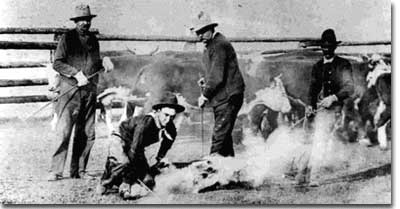41b. The Ways of the Cowboy

Mining was not the only bonanza to be found in the West. Millions could be made in the cattle industry. A calf bought for $5 in Southern Texas might sell for $60 in Chicago. The problem was, of course, getting the cattle to market.
In 1867, Joseph McCoy tracked a path known as the Chisholm Trail from Texas to Abilene, Kansas. The Texas cowboys drove the cattle the entire distance — 1500 miles. Along the way, the cattle enjoyed all the grass they wanted, at no cost to the ranchers. At Abilene and other railhead towns such as Dodge City and Ellsworth, the cattle would be sold and the cowboys would return to Texas.
No vision of the American West is complete without the cowboy. The imagery is quintessentially American, but many myths cloud the truth about what life was like on the long drive.
Myth vs. Reality
Americans did not invent cattle raising. This tradition was learned from the vaquero, a Mexican cowboy. The vacqueros taught the tricks of the trade to the Texans, who realized the potential for great profits.
The typical cowboy wore a hat with a wide brim to provide protection from the unforgiving sunlight. Cattle kicked up clouds of dust on the drive, so the cowboy donned a bandanna over the lower half of his face. Chaps, or leggings, and high boots were worn as protection from briars and cactus needles.
Contrary to legend, the typical cowboy was not a skilled marksman. The lariat, not the gun, was how the cattle drover showed his mastery. About a quarter of all cowboys were African Americans, and even more were at least partially Mexican. To avoid additional strain on the horses, cowboys were usually smaller than according to legend.
The lone cowboy is an American myth. Cattle were always driven by a group of drovers. The cattle were branded so the owner could distinguish his steer from the rest. Several times per drive, cowboys conducted a roundup where the cattle would be sorted and counted again.
Work was very difficult. The workdays lasted fifteen hours, much of which was spent in the saddle. Occasionally, shots were fired by hostile Indians or farmers. Cattle rustlers sometimes stole their steers.
One of the greatest fears was the stampede, which could result in lost or dead cattle or cowboys. One method of containing a stampede was to get the cattle to run in a circle, where the steer would eventually tire.
Upon reaching Abilene, the cattle were sold. Then it was time to let loose. Abilene had twenty-five saloons open all hours to service incoming riders of the long drive.
Twilight of the Cowboy
The heyday of the long drive was short. By the early 1870s, rail lines reached Texas so the cattle could be shipped directly to the slaughterhouses. Ranchers then began to allow cattle to graze on the open range near rail heads. But even this did not last. The invention of barbed wire by Joseph Glidden ruined the open range. Now farmers could cheaply mark their territory to keep the unwanted steers off their lands. Overproduction caused prices to fall, leading many ranchers out of business.
Finally, the winter of 1886-87 was one of the worst in American history. Cattle died by the thousands as temperatures reached fifty below zero in some parts of the West. The era of the open range was over.






